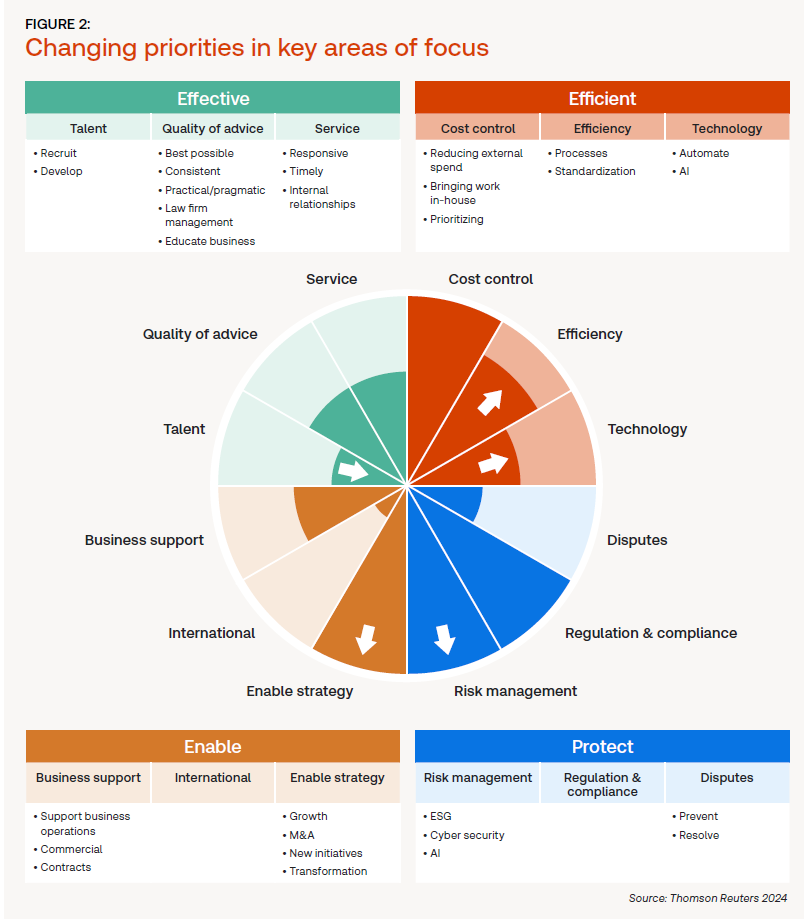Most corporate legal counsel believe AI and GenAI will have a transformative effect on the profession; however, it’s not just AI risks that law departments should focus on but rather how to make AI work for them
Generative artificial intelligence (GenAI) technology holds the potential for a new way of working within corporate law departments, with the potential to transform contract drafting and analysis, legal research, document summarization and review, and much more. Indeed, through GenAI, there is the possibility to touch every function within the law department in some manner.
According to the Thomson Reuters Institute’s recent 2024 State of the Corporate Law Department report, general counsel (GCs) and chief legal officers anticipate major change. Of survey respondents, 42% said they anticipate the emergence of AI and GenAI to have a transformational impact on the legal profession, more than double the percentage of any other trend including the economy and regulation. An additional 32% said they expect AI and GenAI to have a high impact, while less than 5% believe it will have little or no impact.
With this in mind, corporate law department leaders are already planning for business changes, including how to best protect the company against the emerging risks that GenAI can bring. In doing so, however, it may be necessary to change how legal departments approach the process of risk mitigation — and how outside counsel should aim to help their clients achieve those risk mitigation goals.
Where’s the risk?
It’s no surprise that the State of the Corporate Law Department report found that today’s GCs need to wear many hats, being tasked with helping protect the business, doing so efficiently and effectively, while simultaneously enabling the overall business to reach its goals. These pressures come as many corporate law department leaders increasingly are asked to do more with less, even as they are being required to consult on business initiatives more than ever before.
When GCs are asked about their specific priorities, however, a few distinct trends emerge. For example, while efficiency and technology have long been a medium-level priority for many legal departments, their importance is beginning to increase. At the same time, risk management and enabling wider business strategy have emerged as two of the absolute top areas of focus for GCs and department leaders on a daily basis, according to the survey.

All four of these growth areas are impacted by the recent introduction of GenAI into the workplace. Not only does increased automation bring more efficiencies, but the opportunity to quickly source answers throughout the organization provides for more effective risk management applications and tighter integration with overall company strategy.
“The purpose of legal work is to memorialize the understanding of parties,” said one GC-level survey respondent. “If we use the common or averaged uses of language across a large sample of cases, it will provide a commonly understood level of communication. That means the average is better than most.”
Another United States-based corporate lawyer added that GenAI “can simplify processes and free up time to allow lawyers to focus on more important aspects of the business and commercial decision-making.”
These potential gains are particularly apt given the types of risks that department leaders see on the horizon. Survey respondents to the also noted that data and cybersecurity risk are far and away the top new and upcoming compliance risks facing their organizations today — 82% pointed to data and cybersecurity as a risk, the only emerging risk to be cited by more than half of respondents. A number of respondents also pointed to third-party or supply chain risk management (44%), know your customer risk (39%), and AI use and deployment (32%) as emerging risks.
Given the awareness of new technologies as an emerging risk, however, it does not necessarily follow that all corporate law department leaders know how to handle these risks. Almost two-thirds (61%) of risk & compliance professionals in the United Kingdom and North America, for instance, describe the current state of strategic risk management and compliance within their organization as “adequate but with room for improvement.”
Risk management in an AI world
Particularly given the fast-evolving pace of modern technologies, it’s imperative to develop a method of attacking new risks. Respondents certainly identify the need: 71% say identifying and mitigating emerging risks is a top priority for their legal department, while 58% say keeping abreast of upcoming regulatory and legislative changes is a top priority.
At the same time, it’s unclear exactly how many legal departments plan to tackle these risks. Only 44% of respondents said they believe there’s an opportunity for AI to help achieve their risk management goals, stating the opinion that GenAI is a risk to be tackled rather than an opportunity to achieve goals.
That may be the wrong tactic, especially since the technology is already poised to help and other competitors may be taking advantage of is use. As one US chief legal officer survey respondent said: “We can already describe high-value, high-impact use cases for a number of areas within the legal, contract management, and compliance areas that will result in huge cost savings and productivity increases as well as unprecedented predictive data analytics for high-value areas such as risk — and we are close to production-ready in early 2024 for some use cases.”
Other respondents said they also have other potential use cases for AI in risk management — such as detecting patterns where risk of losses may occur, scanning contracts to create a risk profile, and tracking and summarizing new legislation as it arises. While these use cases remain nascent in GenAI’s current state, the rapidly evolving nature of the technology means that potential use in everyday legal work is likely to arrive sooner rather than later.
The role of outside law firms
There also is one other key outlet for tackling these emerging risks that corporate law department leaders can utilize in a new way: outside law firms. Many forward-looking law firms also are exploring the use of GenAI and new technologies in their work; however, for now, current use cases often are more focused on identifying internal efficiencies rather than providing outside client solutions.
According to the report, 72% of corporate law department respondents said that use of appropriate technologies is a consideration for choosing their outside law firms, only slightly behind the outside firm’s purpose or values as the top consideration in selection. When it comes to GenAI, however, corporate law department leaders have an opportunity to dictate what they mean by “appropriate” technology usage, dictating that their outside firms should not only be using the technology for efficiency’s sake, but also to help the internal legal teams reach their risk mitigation goals as well.
Indeed, some corporate law department leaders are already seeing GenAI working hand-in-hand with their outside law firms as part of the team. One GC respondent said: “I work for a small legal department with various legal needs including contract review, regulatory compliance, commercial transactions, corporate structure review, and capital markets. Generative AI will be the perfect tool and assistant in that it will not only provides a database and legal knowledge, but [that it] also provides insights and intelligence as a co-worker.”
The future for many corporate law departments is likely to be an integrated team, one that not only relies on legal know-how to identifies risks, but that incorporates a combination of outside counsel, technology, legal service providers, and the law department’s own attorneys to determine the best risk mitigation tactics and potential business opportunities.
Most importantly, the time to start building those teams — and becoming familiar with how to fit today’s advanced technology into the company’s wider plans — has rapidly approached.







